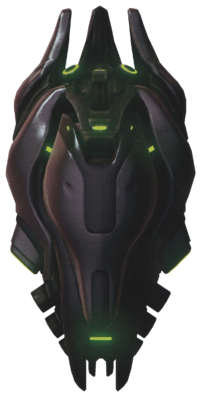Gloto-pattern Breaching Carapace: Difference between revisions
From Halopedia, the Halo wiki
m (Text replacement - "<references/>" to "{{Ref/Sources}}") |
m (Text replacement - "<ref name="([^"=>]+)" ?\/>" to "{{Ref/Reuse|$1}}") |
||
| Line 8: | Line 8: | ||
|cost= | |cost= | ||
|length={{Convert|3.9|m|ft|sp=us}}<ref name="H4EVG">'''Halo 4: The Essential Visual Guide''', ''page 121''</ref> | |length={{Convert|3.9|m|ft|sp=us}}<ref name="H4EVG">'''Halo 4: The Essential Visual Guide''', ''page 121''</ref> | ||
|width={{Convert|3.9|m|ft|sp=us}} | |width={{Convert|3.9|m|ft|sp=us}}{{Ref/Reuse|H4EVG}} | ||
|height={{Convert|8|m|ft|sp=us}} | |height={{Convert|8|m|ft|sp=us}}{{Ref/Reuse|H4EVG}} | ||
|mass= | |mass= | ||
|max speed= | |max speed= | ||
| Line 27: | Line 27: | ||
}} | }} | ||
The '''Type-51 Individual Breaching Carapace''' is a type of multi-occupant [[Covenant drop pod|orbital entry vehicle]] used by the [[Covenant remnants]], namely [[Jul 'Mdama's Covenant|Jul 'Mdama's faction]]. Developed by [[Lodam Armory]], the T-51 IBC is the most prominent model of drop pod in the post-[[Human-Covenant War|Covenant War]] era. It is used for rapid insertions to planetary targets or even enemy vessels. Mostly supplanting the single-occupant pods favored in the past, it can carry up to five occupants; for larger-scale deployment, the Covenant employs the larger [[Type-54 Mass Deployment Carapace]]. The T-51 IBC is similar in size to the multiple-troop variant used by the original [[Covenant]] but sleeker and more elongated in design. It is equipped with forward-braking thrusters for deceleration and a set of terrain-locking prongs on its underside to anchor the pod to the ground. | The '''Type-51 Individual Breaching Carapace''' is a type of multi-occupant [[Covenant drop pod|orbital entry vehicle]] used by the [[Covenant remnants]], namely [[Jul 'Mdama's Covenant|Jul 'Mdama's faction]]. Developed by [[Lodam Armory]], the T-51 IBC is the most prominent model of drop pod in the post-[[Human-Covenant War|Covenant War]] era. It is used for rapid insertions to planetary targets or even enemy vessels. Mostly supplanting the single-occupant pods favored in the past, it can carry up to five occupants; for larger-scale deployment, the Covenant employs the larger [[Type-54 Mass Deployment Carapace]]. The T-51 IBC is similar in size to the multiple-troop variant used by the original [[Covenant]] but sleeker and more elongated in design. It is equipped with forward-braking thrusters for deceleration and a set of terrain-locking prongs on its underside to anchor the pod to the ground.{{Ref/Reuse|H4EVG}} | ||
==Gallery== | ==Gallery== | ||
Revision as of 12:04, April 15, 2021
| Gloto-pattern Breaching Carapace | |
|---|---|

| |
| Production information | |
|
Manufacturer: |
|
|
Product line: |
|
| Technical specifications | |
|
Length: |
3.9 meters (13 ft)[1] |
|
Width: |
3.9 meters (13 ft)[1] |
|
Height: |
8 meters (26 ft)[1] |
|
Engine(s): |
Impulse drive systems |
|
Hull: |
Unknown Covenant material |
|
Complement: |
1-5 |
| Usage | |
|
In service: |
|
|
Affiliation: |
|
The Type-51 Individual Breaching Carapace is a type of multi-occupant orbital entry vehicle used by the Covenant remnants, namely Jul 'Mdama's faction. Developed by Lodam Armory, the T-51 IBC is the most prominent model of drop pod in the post-Covenant War era. It is used for rapid insertions to planetary targets or even enemy vessels. Mostly supplanting the single-occupant pods favored in the past, it can carry up to five occupants; for larger-scale deployment, the Covenant employs the larger Type-54 Mass Deployment Carapace. The T-51 IBC is similar in size to the multiple-troop variant used by the original Covenant but sleeker and more elongated in design. It is equipped with forward-braking thrusters for deceleration and a set of terrain-locking prongs on its underside to anchor the pod to the ground.[1]
Gallery
- Halo4-Concept-CovDropPod-01.jpg
Renders of Type-51 IBC in Halo 4.
- Halo4-Concept-CovDropPod-02.jpg
Closeup detail view of the T-51 drop pod render.
List of appearances
- Halo 4 (First appearance)
- Halo: Escalation
Sources
| |||||||||||||||||||||||||||||||||||||